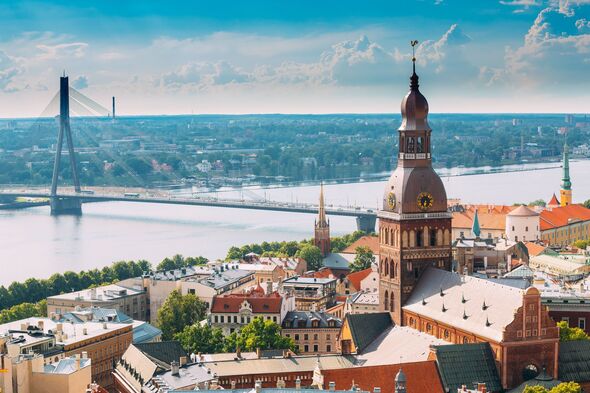World
Riga Central Market Welcomes 100,000 Visitors Daily

Riga, the capital of Latvia, is home to the largest market in Europe, attracting approximately 100,000 visitors daily. Known for its stunning architecture and rich history, Riga Central Market is more than just a shopping destination; it is a cultural landmark that has been operational since the 16th century. With its unique pavilions constructed from repurposed German Zeppelin hangars, the market reflects both the city’s architectural heritage and its vibrant trading history.
Located on the banks of the Daugava River, Riga boasts a population of just under 600,000. The city’s historical centre is recognized as a UNESCO World Heritage Site, celebrated for its Art Nouveau and Jugendstil architecture. The Central Market, which covers an area of 778,000 square feet, is a vital part of Riga’s identity and continues to draw locals and tourists alike.
Historical Significance and Market Evolution
Riga Central Market’s history dates back to the 16th century when local farmers sold produce along the Daugava River. However, as demand grew, the market became overcrowded and unsanitary, prompting the move to a new enclosed location in the 1920s. Construction began in 1924, using second-hand materials from World War I, and the market officially opened in 1930. The five main pavilions, designed in a mix of Neoclassical and Art Deco styles, are among the last remaining Zeppelin hangars in the world.
Over the decades, Riga Central Market has weathered significant historical events, including the Nazi and Soviet occupations. During the Soviet era, it was renamed the Central Kolkhoz Market and was recognized as one of the best markets in the state. Statistics from 1961 reveal that the market facilitated the sale of over 200,000 metric tons of poultry and more than 22,000 metric tons of fruits and vegetables annually.
Modern Day Challenges and Cultural Importance
Today, the market remains a bustling hub, serving between 80,000 and 100,000 customers daily, according to A Brummie Home and Abroad. The reconstructed Gastronomy Pavilion, which reopened in January 2019 after a €1.7 million renovation, highlights the market’s commitment to preserving its cultural significance. Yet, the rise of supermarkets poses challenges to its traditional model. The city council has prioritized efforts to maintain the market’s mission and cultural value amidst changing shopping habits.
Beyond the Central Market, Riga offers numerous attractions that enrich its historical narrative. Visitors can explore the Freedom Monument, St. Peter’s Church, and the House of the Blackheads, a prominent public building that now serves as an event centre and museum. These sites contribute to the city’s charm, which one recent visitor described as “magical” and reminiscent of a fairy tale.
For those looking to experience Riga, direct flights to Riga International Airport (RIX) are available from the UK, with airlines such as Ryanair and easyJet. The average flight time is under three hours, and September is noted as the most economical month to visit, with fares as low as £19 for a one-way ticket from Stansted according to Skyscanner.
As Riga continues to evolve, its market stands as a testament to the city’s resilience and cultural richness, ensuring its place as a key destination in Europe.
-

 Entertainment3 months ago
Entertainment3 months agoAnn Ming Reflects on ITV’s ‘I Fought the Law’ Drama
-

 Entertainment4 months ago
Entertainment4 months agoKate Garraway Sells £2 Million Home Amid Financial Struggles
-

 Health3 months ago
Health3 months agoKatie Price Faces New Health Concerns After Cancer Symptoms Resurface
-

 Entertainment3 months ago
Entertainment3 months agoCoronation Street’s Carl Webster Faces Trouble with New Affairs
-

 Entertainment3 months ago
Entertainment3 months agoWhere is Tinder Swindler Simon Leviev? Latest Updates Revealed
-

 World2 weeks ago
World2 weeks agoBailey Announces Heartbreaking Split from Rebecca After Reunion
-

 Entertainment2 weeks ago
Entertainment2 weeks agoCoronation Street Fans React as Todd Faces Heartbreaking Choice
-

 Entertainment4 months ago
Entertainment4 months agoMarkiplier Addresses AI Controversy During Livestream Response
-

 Science1 month ago
Science1 month agoBrian Cox Addresses Claims of Alien Probe in 3I/ATLAS Discovery
-

 Health5 months ago
Health5 months agoCarol Vorderman Reflects on Health Scare and Family Support
-

 Entertainment4 months ago
Entertainment4 months agoKim Cattrall Posts Cryptic Message After HBO’s Sequel Cancellation
-

 Entertainment3 months ago
Entertainment3 months agoOlivia Attwood Opens Up About Fallout with Former Best Friend



















